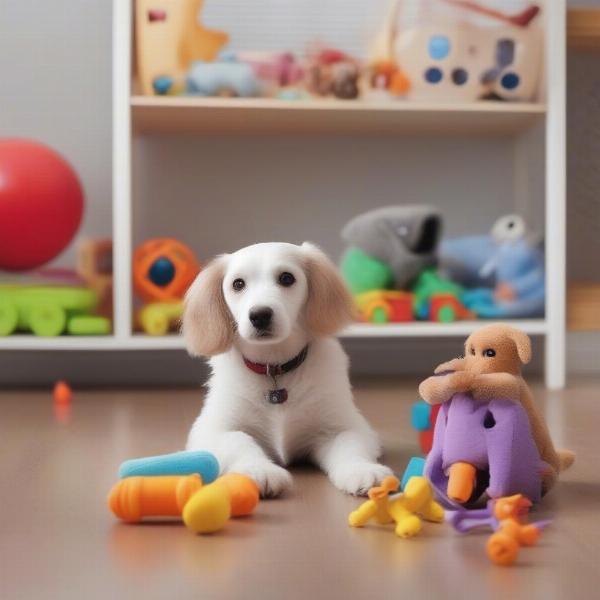A toy dog with house conjures up images of pampered pups living in luxury. While a dedicated dog house inside your home might not always be practical, creating a comfortable and safe space for your small breed companion is essential. This article will guide you through setting up the perfect indoor environment for your toy dog, covering everything from designated areas and cozy beds to interactive toys and essential safety measures.
Small dogs have specific needs, and providing them with their own “house” within your home can contribute significantly to their well-being. This designated area offers them a sense of security, a place to retreat when overwhelmed, and a consistent environment for rest and play. Whether you opt for a dog bed, a crate, or a designated corner, the key is to create a space that your toy dog recognizes as their own.
Choosing the Right “House” for Your Toy Dog
What constitutes a “house” for a toy dog can vary. A toy dog house could be a plush dog bed, a comfortable crate, or even a designated corner of a room. The best choice depends on your dog’s personality and your home’s layout. Some dogs thrive in the den-like security of a crate, while others prefer the freedom of a soft bed. Consider your dog’s sleeping habits, anxiety levels, and chewing tendencies when making your decision.
Dog Beds for Toy Breeds
For dogs that enjoy lounging, a plush, appropriately sized dog bed is ideal. Look for beds with washable covers and supportive cushioning for their small joints. Elevated beds can be a good choice for older dogs or those with mobility issues.
Crates for Toy Dogs
Crates, when used correctly, can be a valuable tool for housetraining and providing a safe haven. Introduce the crate positively, using treats and toys, and never use it as a punishment. Ensure the crate is large enough for your toy dog to stand, turn around, and lie down comfortably. You can find more information about suitable crates on our crates for dogs page.
Designated Areas
If space allows, dedicate a corner of a room to your toy dog. This could be a quiet area with their bed, toys, and water bowl. This option works well for dogs that are already housetrained and comfortable in a more open environment.
 Toy dog playing with toys inside their designated house area
Toy dog playing with toys inside their designated house area
Essential Elements of Your Toy Dog’s Indoor Space
Beyond the “house” itself, consider these essential elements:
- Comfort: Soft bedding, blankets, and perhaps even a familiar item of clothing can make the space more inviting.
- Safety: Remove any potential hazards, such as electrical cords, toxic plants, and small objects they could swallow.
- Enrichment: Provide a variety of toys, including chew toys, puzzle toys, and interactive toys, to keep your dog mentally stimulated. Check out our dog cat toys page for some ideas.
- Cleanliness: Regularly clean the bedding and surrounding area to maintain a hygienic environment.
Addressing Common Concerns with Toy Dogs and Indoor Spaces
What if my toy dog is destructive? Choose durable toys and bedding designed for chewers. Crate training can also be beneficial.
How do I prevent separation anxiety? Establish a consistent routine, provide plenty of enrichment, and consider using a dog room divider to create a safe space if necessary. Our article, “my new rescue dog is afraid of my husband” might offer some additional insights into managing anxiety.
Conclusion
Creating a dedicated indoor space for your toy dog contributes significantly to their well-being and happiness. By carefully considering their individual needs and providing a comfortable, safe, and enriching environment, you can ensure your small companion thrives in your home. Remember to prioritize safety, cleanliness, and mental stimulation to create the ideal indoor “house” for your beloved toy dog.
FAQ
- Do toy dogs need their own space? Yes, having a designated area helps them feel secure and reduces anxiety.
- What type of bed is best for a toy dog? Consider your dog’s age, sleeping habits, and any potential health issues when choosing a bed.
- Is crate training recommended for toy dogs? Crates can be a valuable tool for housetraining and providing a safe haven, but they should be introduced positively.
- How can I keep my toy dog entertained indoors? Provide a variety of toys, including chew toys, puzzle toys, and interactive toys.
- What should I do if my toy dog is destructive? Choose durable toys and bedding designed for chewers, and consider crate training.
About ILM Dog: ILM Dog is your trusted resource for expert advice on dog breeds, health, training, nutrition, grooming, and much more. We’re committed to providing practical, reliable information to help dog owners worldwide care for their canine companions. Whether you’re a new dog owner or a seasoned expert, ILM Dog offers valuable insights and guidance. Contact us at [email protected] or +44 20-3965-8624 for expert advice on all aspects of dog care, from selecting the right breed to ensuring their lifelong health and happiness.